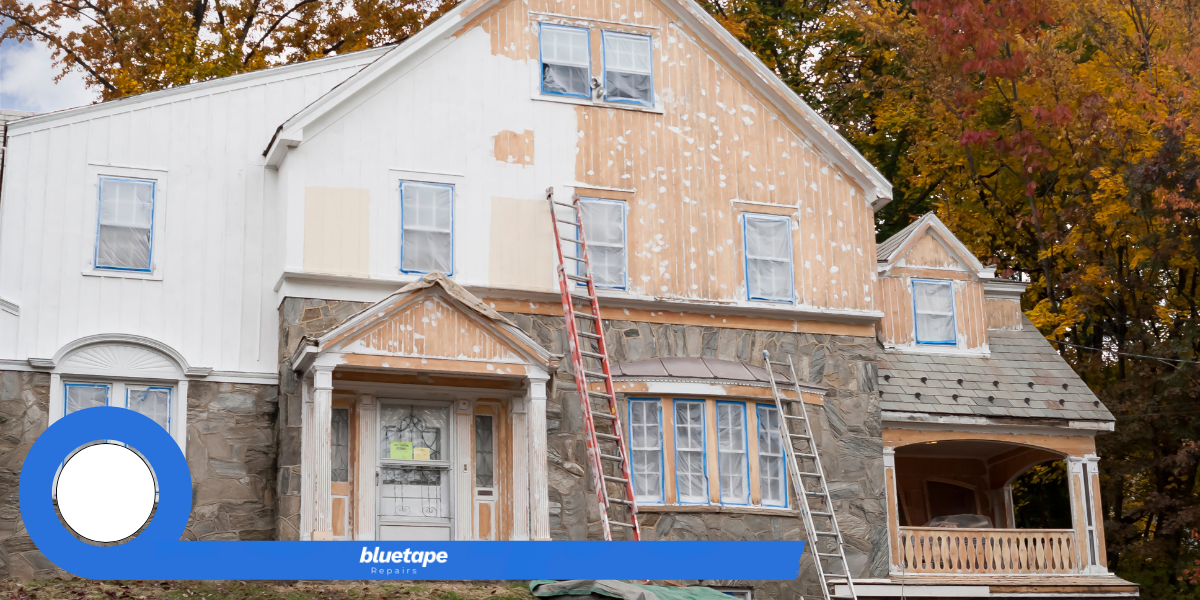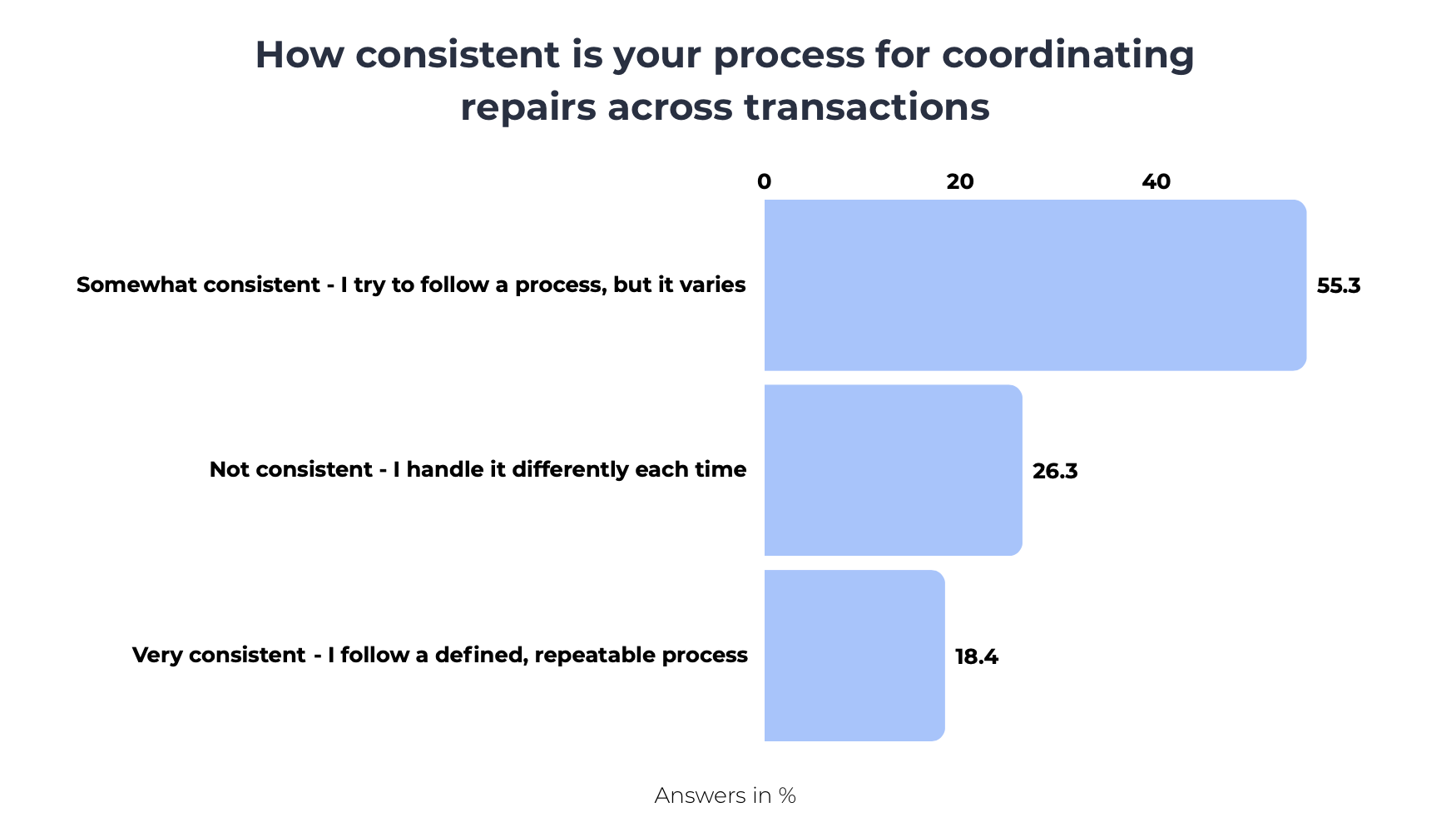Pre-Listing Repairs vs Updates: What’s the Difference?
Read Time 7 mins | Written by: Chris Lambert

Key Takeaways
Pre-listing repairs fix what’s unsafe or failing in a home, while pre-listing updates refresh how it looks and lives—and that distinction matters in a market full of older homes and inspection-sensitive buyers. When agents separate those two tracks inside a clear repair workflow, they can neutralize likely inspection issues, use targeted updates to help the home feel move-in ready, and lean on Bluetape’s integrated pre-list process to keep deals moving instead of blowing up over repairs.
America’s listings now tilt heavily toward older homes. American Community Survey data analyzed by NAHB shows that the median age of owner-occupied homes has climbed to 41 years, and roughly 48% of the stock dates back to the 1980s or earlier.
At the same time, buyers have become more selective about what they’ll take on. A summary of the National Association of REALTORS® 2025 Profile of Home Buyers and Sellers in Chicago Agent Magazine notes that previously owned homes still make up about 84% of purchases, but the share of new homes has risen to 16%, and 43% of new-home buyers say they chose new construction specifically to avoid renovations or maintenance problems.
On top of that, the National Association of REALTORS® 2025 Profile of Home Staging reports that nearly half of sellers’ agents saw staged homes spend less time on market, and about three in ten saw a 1%–10% increase in sale price after staging.
Inside that tension—aging systems on one side, elevated expectations on the other—agents reach for two different tools before they list: pre-listing repairs and pre-listing updates. The labels often get used interchangeably. In practice, they describe very different kinds of work.
What counts as a pre-listing repair?
Pre-listing repairs deal with what’s broken, unsafe, or clearly at the end of its useful life. They live in the world of function and risk, not style.
In Bluetape projects, pre-listing repairs typically show up in categories like:
- Roof leaks, failed or marginal roofing, and compromised flashing
- Active plumbing leaks, slow drains, or evidence of past water damage that hasn’t been properly addressed
- Electrical hazards: double-tapped breakers, outdated or overloaded panels, missing GFCI protection in wet areas
- HVAC systems that aren’t operating correctly, or that need critical repairs to pass inspection
- Rot, soft spots, or structural concerns in decks, stairs, or exterior trim
These items show up in inspection reports whether anyone likes it or not. When they’re handled before the listing goes live, the inspection report reads differently: instead of a long narrative about neglect, it becomes a shorter list of remaining punch-list items and buyer preferences.
In a cancellation environment where roughly 15% of 2025 home-purchase agreements are falling through and 70% of surveyed Redfin agents cite inspection or repair issues as the top driver, clearing obvious repair landmines up front has become a form of deal protection, not optional “nice-to-have” work. Those numbers come from Redfin’s October 2025 report on home-purchase cancellations.
What counts as a pre-listing update?
Pre-listing updates, by contrast, focus on how the home looks, feels, and photographs. They don’t usually change whether a system works; they change how buyers experience the property.
Common pre-listing updates include:
- Interior paint that neutralizes loud colors or refreshes worn walls
- Flooring updates, from replacing stained carpet to refinishing hardwoods or adding LVP in key areas
- Lighting and fixture swaps that modernize the home’s feel without moving walls
- Cabinet hardware, faucets, and mirrors that pull older kitchens and bathrooms into this decade
- Minor exterior refreshes: front door paint, landscaping clean-up, and curb-appeal touches
The impact of that work isn’t hypothetical. The 2025 Profile of Home Staging from NAR found that 29% of listing agents saw staged homes command 1%–10% higher offers, and nearly half said staging reduced time on market compared with similar un-staged homes. Those are classic “update” effects: the systems didn’t change, but the way buyers valued and moved on the property did.
Updates move the listing along the spectrum from “project” to “finished,” even when the underlying systems haven’t changed. They answer the question: does this home feel like somewhere a buyer wants to live?
Repairs answer “can we live here?”; updates answer “do we want to?”
In older homes, buyers are trying to answer two different questions at once.
Pre-listing repairs speak to safety, functionality, and near-term risk. They’re about whether the roof will keep water out, the electrical system will pass inspection, and the plumbing won’t surprise anyone two months after closing. When those fundamentals look questionable—or worse, obviously neglected—buyers start mentally pricing in worst-case scenarios and, increasingly, look for exits during the inspection window.
Pre-listing updates speak to comfort, taste, and lifestyle. They’re about whether buyers can see their life in the space: the kitchen they’ll cook in, the living room they’ll host in, the bedrooms that feel calm instead of dated. Updates shape emotional response and perceived value, even when they don’t change the bones of the house.
Because the U.S. housing stock is skewing older and maintenance has often lagged, buyers know they’re walking into a market where hidden issues are plausible. A 2025 survey from Today’s Homeowner found that 59% of homeowners are putting off needed repairs due to cost, and 79% expect to tackle repairs in the next six months. A separate 2025 study from Nationwide reports that 25% of homeowners have deferred necessary repairs, with 60% citing cost as the main reason.
When buyers see unresolved repair problems alongside clear cosmetic neglect, they often assume the worst. When they see a home where core problems are addressed and the remaining work is mostly preference and style, they interpret the same age very differently.
Where the lines blur and why it matters for the inspection report
Not every project fits neatly into one box. Replacing stained, 20-year-old carpet before listing, for example, can feel like an update and a repair at the same time. The same goes for addressing long-ignored exterior trim rot as part of a paint job.
From a workflow standpoint, the key distinction isn’t what the work looks like on social; it’s how it will show up on the inspection report and in the buyer’s mental math.
- Work that removes likely inspection red flags—like fixing active leaks, correcting electrical hazards, and resolving obvious structural issues—behaves like a pre-listing repair, even when it also improves appearance.
- Work that primarily changes how spaces read in photos and showings—paint, fixtures, staging, most landscaping—behaves like a pre-listing update, even when it quietly covers up years of cosmetic wear.
Agents in Bluetape markets often make this distinction when they look at a scope. The question isn’t just “what will make the home look best?” It’s also “which line items are likely to explode on the inspection report if we don’t deal with them now?”
How agents sequence repairs and updates inside a modern workflow
In practice, the most effective pre-listing plans treat repairs and updates as two coordinated tracks, not one blended to-do list.
On the repair side, agents work with Bluetape to identify and address the most serious issues before the listing hits the market: roof and water intrusion, electrical safety, plumbing problems, and obvious structural concerns. That work shrinks the future inspection report and changes the tone of the conversation when the inspector does their job.
On the update side, the same in-house crews handle tightly scoped visual improvements—paint, flooring, lighting, trim, and other high-impact touches—that elevate photos and in-person impressions. The goal isn’t to hide the age of the home; it’s to show that an older property has been actively cared for and brought forward.
Because Bluetape runs both tracks inside a single workflow, agents don’t have to manage separate vendors, bids, and timelines for “real repairs” and “cosmetic stuff.” They see one integrated scope that distinguishes between risk-reducing repairs and value-building updates, then decide how far to go based on price point, timelines, and seller goals.
Bluetape’s own data from the 2025 Real Estate Repair Report backs up the need for that structure: only 18% of responding agents follow a defined repair workflow. Nearly a third spend six or more hours per deal coordinating repair logistics.


Two different levers, one outcome: protecting the deal
In an inventory of older homes and more cautious buyers, pre-listing repairs and pre-listing updates are no longer interchangeable buzzwords. They’re two different levers in the same deal-protection system.
Repairs change the risk profile of the home. Updates change the way that risk profile is perceived. When agents treat them as distinct but coordinated parts of a modern repair workflow, they give buyers fewer reasons to walk away at inspection—and more reasons to compete when the listing first goes live.
